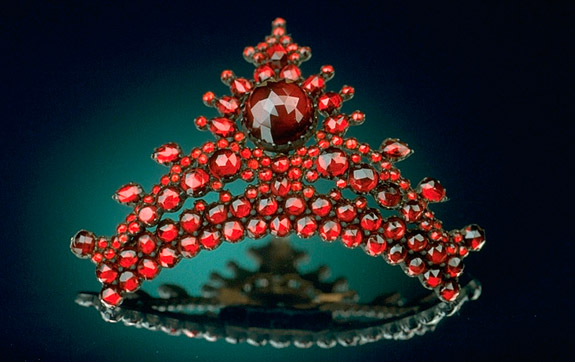January 8th, 2015
Entombed with the Pharaohs of Ancient Egypt and often mistaken for ruby, garnets have been coveted by kings and commoners alike for thousands of years.

The fabulous and versatile garnet comes in a wide array of natural colors, including pink, purple, orange, yellow, violet, green, black, brown — but is best known for the ones of deep-red hue.
The official birthstone for January, garnet gets its name from the Latin word “granatum,” meaning pomegranate seed.
Beautifully representing garnets in the National Gem Collection at the Smithsonian National Museum of Natural History is the Victorian-era hairpin (above) that was donated in 1937 by Ales and Maria Herdlicka. The piece is set with Bohemian pyrope garnets that were sourced from an area that is now the Czech Republic.
The hairpin is typical of Bohemian garnet jewelry, which was known for its close-set rose-cut stones. The gems were faceted on the top and flat on the bottom.
Pyrope garnets are the most common form of garnet and are typically a rich, deep-red color. According to the Smithsonian, pyrope garnets were often confused with ruby, due to their fiery appearance. In fact, the Greek word “pyropos” means “firelike.”
Until the late 19th century, Bohemia was the main source of pyrope garnets. Although the original source has been depleted, garnets are still mined in Europe, North America, Africa, Asia and Australia.
In addition to the popular pyrope garnets, other varieties commonly seen in jewelry include almandine, andradite, demantoid, grossularite, hessonite, rhodolite, tsavorite, spessartine and uvarovite. Garnets achieve their range of color from trace amounts of iron, manganese, calcium or aluminium their chemical makeup.
Photo by Chip Clark/Smithsonian National Gem Collection

The fabulous and versatile garnet comes in a wide array of natural colors, including pink, purple, orange, yellow, violet, green, black, brown — but is best known for the ones of deep-red hue.
The official birthstone for January, garnet gets its name from the Latin word “granatum,” meaning pomegranate seed.
Beautifully representing garnets in the National Gem Collection at the Smithsonian National Museum of Natural History is the Victorian-era hairpin (above) that was donated in 1937 by Ales and Maria Herdlicka. The piece is set with Bohemian pyrope garnets that were sourced from an area that is now the Czech Republic.
The hairpin is typical of Bohemian garnet jewelry, which was known for its close-set rose-cut stones. The gems were faceted on the top and flat on the bottom.
Pyrope garnets are the most common form of garnet and are typically a rich, deep-red color. According to the Smithsonian, pyrope garnets were often confused with ruby, due to their fiery appearance. In fact, the Greek word “pyropos” means “firelike.”
Until the late 19th century, Bohemia was the main source of pyrope garnets. Although the original source has been depleted, garnets are still mined in Europe, North America, Africa, Asia and Australia.
In addition to the popular pyrope garnets, other varieties commonly seen in jewelry include almandine, andradite, demantoid, grossularite, hessonite, rhodolite, tsavorite, spessartine and uvarovite. Garnets achieve their range of color from trace amounts of iron, manganese, calcium or aluminium their chemical makeup.
Photo by Chip Clark/Smithsonian National Gem Collection



